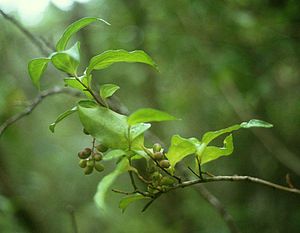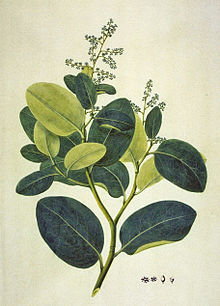Griselinia
| Griselinia | ||||||||||||
|---|---|---|---|---|---|---|---|---|---|---|---|---|

Griselinia racemosa , branch with fruits and leaves. |
||||||||||||
| Systematics | ||||||||||||
|
||||||||||||
| Scientific name of the family | ||||||||||||
| Griseliniaceae | ||||||||||||
| Takht. | ||||||||||||
| Scientific name of the genus | ||||||||||||
| Griselinia | ||||||||||||
| G. Forest. |
Griselinia is the only genus of the family of Griseliniaceae within the Doldenblütlerartigen (Apiales).
description


Vegetative characteristics
They are always woody plants, bushes , small trees or lianas . Sometimes they grow epiphytically . They are mostly evergreen .
The alternate and spiral or double-row leaves on the branches are divided into a petiole and a leaf blade. The leaf blades are simple and leathery. In some species the leaf margins are serrated, the others have smooth leaf margins. In some species, the leaves are asymmetrical. Stipules are missing.
Generative characteristics
They are dioecious separate sexes ( diocesan ). The inflorescences are structured differently. The unisexual flowers are small, five-fold and radial symmetry . The male flowers each have five sepals and five petals ; the sepals of the female flowers are tiny and petals are often absent. Male flowers contain five free, fertile stamens . The female flowers are three carpels an under constant ovary grown with three punches, but only two carpels are fertile .
They form lonely berries .

Systematics and distribution
The genus Griselinia G.Forst. was set up in 1786 by Georg Forster in Florulae Insularum Australium Prodromus , page 75. The generic name Griselinia probably honors the Italian polymath Francesco Griselini (1717–1787). Type species is Griselinia lucida (JRForst. & G.Forst.) G.Forst. The Griseliniaceae family was established in 1987 by Armen Leonovich Takhtajan in Sistema Magnoliofitov , page 209.
In the past, the genus Griselinia was classified in the dogwood family (Cornaceae).
They have a strongly disjointed area : New Zealand and southern South America ( Chile , Argentina and southeastern Brazil ). Such a distribution can be found in some ancient groups of plants - see Gondwana urcontinent. They are a typical example of the Antarctic flora .
There are only six species in the genus Griselinia and thus also in the family Griseliniaceae:
- New Zealand species:
- The two New Zealand species are large shrubs or trees that can reach heights of 4 to 20 meters.
- Griselinia littoralis (Raoul) Raoul : The leathery, deep green leaves are oval and 6 to 14 cm long. The greenish to yellow, small flowers provide bees with a lot of nectar. The small fruits are black-purple in color. Its Maori name is "Kapuka" or "Papauma". This species is also used as an ornamental plant.
- Griselinia lucida G.Forst. : Its Maori name is "Akapuka". It differs from Griselinia littoralis mainly in that it has longer leaves that are 12 to 18 cm long.
- South American species:
- The South American species are small shrubs that reach heights of 1 to 5 meters. All species are called "Yelmo" in their homeland.
- Griselinia carlomunozii M.O.Dillon & Muñoz-Schick : The home is the coastal strip of northern Chile ( Region Antofagasta = Region II).
- Griselinia jodinifolia (Griseb.) Deaf. : It is common in Chile.
- Griselinia racemosa (Phil.) Deaf. : It only occurs in the southern Chilean regions of Los Lagos and Aisén (regions X and XI) and in the adjacent area in Argentina (the western province of Chubut ).
- Griselinia ruscifolia (Clos) deaf. : It is common in Argentina, Chile and southeastern Brazil .
- Griselinia scandens (Ruiz & Pav.) Deaf. : It is common in central and southern Chile.
swell
- The family of Griseliniaceae in APWebsite . (English)
- Description of the family at DELTA. (English)
Individual evidence
- ↑ a b c Griseliniaceae at Tropicos.org. Missouri Botanical Garden, St. Louis, accessed January 9, 2019.
- ↑ Lotte Burkhardt: Directory of eponymous plant names. Extended Edition. Botanic Garden and Botanical Museum Berlin, Free University Berlin Berlin 2018. online.
Web links
- Entries about Griselinia in Plants For A Future
- Griseliniaceae in the Germplasm Resources Information Network (GRIN), USDA , ARS , National Genetic Resources Program. National Germplasm Resources Laboratory, Beltsville, Maryland.
- Profile of Griselinia scandens .